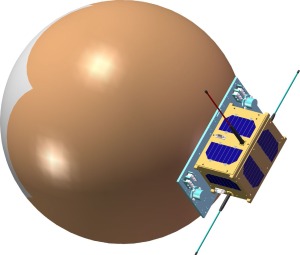The ARRL is reporting that another Amateur Radio satellite is set to launch from China. CAMSAT CEO Alan Kung, BA1DU, reports that CAS-7B (BP-1B) is expected to launch on July 22 at 0500 UTC, on the Hyperbola 1 vehicle. CAS-7B is a spherical spacecraft, 500 millimeters (approximately 19.7 inches) in diameter with a mass of 3 kilograms (about 6.6 pounds). The CW telemetry beacon will be on 435.715 MHz. The V/U FM 16 kHz wide transponder downlink is 435.690 MHz, and the uplink is 145.900 MHz. The launch from Jiuquan will be into a 300-kilometer (approximately 186-mile), 42.7° inclination orbit.
And from AMSAT-UK
CAS-7B with FM transponder launched
The Amateur Radio satellite CAS-7B (BP-1B), carrying an FM transponder, was launched at 05:00 GMT on July 25, 2019 and the FM transponder and Telemetry Beacon have been received.
The satellite was launched on Hyperbola-1 from Jiuquan into a 300 km 42.7 degree inclination orbit. CAS-7B is expected to have a lifetime of less than a month before reentry.
CAS-7B is a spheriform spacecraft of 500 mm diameter with a mass of 3 kg
• CW Telemetry Beacon: 435.715 MHz 20 dBm
• V/U FM Transponder Downlink: 435.690 MHz 20 dBm, 16 kHz bandwidth
• V/U FM Transponder Uplink: 145.900 MHz 16 kHz bandwidth
• CW Telemetry Beacon: 435.715 MHz 20 dBm
• V/U FM Transponder Downlink: 435.690 MHz 20 dBm, 16 kHz bandwidth
• V/U FM Transponder Uplink: 145.900 MHz 16 kHz bandwidth
Update July 30, 2019: CAS-7B Designated BIT Progress-OSCAR 102 (BO-102)
On July 25, 2019, the CAS-7B (BP-1B) microsatellite was launched on a Hyperbola-1 launch vehicle from the Jiuquan Space Center, China.
CAS-7B (BP-1B) was developed by the Chinese Amateur Satellite Group (CAMSAT), and in cooperation with the Beijing Institute of Technology (BIT). CAMSAT completed the project planning, design, build, and testing, and manages the on-orbit operation of the satellite. BIT provided the satellite environmental testing, launch support, and financial support. Many students from BIT were involved with the project, learning about satellite technology and amateur radio. The satellite carries a CW telemetry beacon and FM repeater that has been active since launch.
At the request of CAMSAT and the BIT team, AMSAT hereby designates CAS-7B (BP-1B) as BIT Progress-OSCAR 102 (BO-102). We congratulate the owners and operators of BO-102, thank them for their contribution to the amateur satellite community, and wish them continued success on this and future projects.
Further CAS-7B information from Alan Kung BA1DU https://amsat-uk.org/2019/06/02/cas7b-bp1b-satellite/

